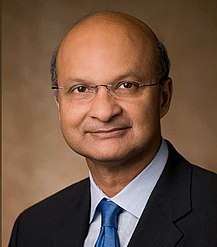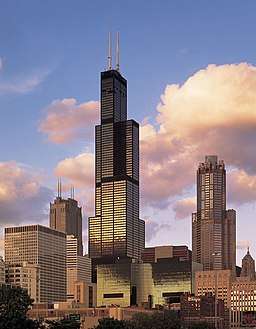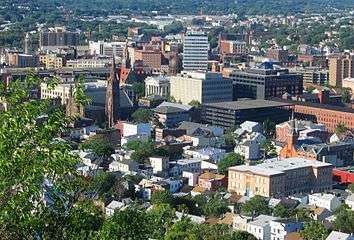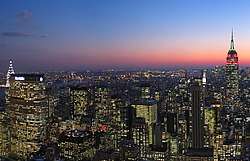Bangladeshi Americans
Bangladeshi Americans (Bengali: বাংলাদেশী মার্কিনী) are Americans of Bangladeshi descent. The majority of Bangladeshi Americans are Bengalis and form the largest group of Bengali Americans. Bangladeshi immigrants have arrived in the United States in large numbers since the early 1970s to become among the fastest growing ethnic communities since that decade. New York City, home to two-thirds of the Bangladeshi American population; Paterson, New Jersey; Atlantic City, New Jersey; Buffalo, New York; as well as Philadelphia, Pennsylvania, Los Angeles, Boston, Atlanta, San Francisco, Detroit, Chicago, Florida, Dallas, Houston, Charlotte, Austin and Hamtramck, Michigan are home to notable Bangladeshi communities.
| Total population | |
|---|---|
| 213,372 (2018 American Community Survey estimate)[1] | |
| Regions with significant populations | |
| |
| Languages | |
| |
| Religion | |
| Majority: Islam Minority: Christianity, Hinduism, Buddhism | |
| Related ethnic groups | |
History
Immigrants from present-day Bangladesh have been in the United States since at least the 1880s.[5]
Bangladeshis have been migrating to the port cities of the United States since 1974 when 154 Bangladeshi arrived in United States leaving behind the hard economic and political times of the still developing Bangladesh who got independence from Pakistan in 1971. Most were workers on the various ships docking from Chittagong, Bangladesh.
Immigration to the United States from Bangladesh grew slowly but steadily through the 1970s and 1980s. Over ten thousand Bangladeshis have immigrated to the United States annually.[2] Many of the migrants settled in urban areas. New York City is home to two-thirds of the Bangladeshi population in the United States. Other cities including Paterson and Atlantic City, New Jersey, Buffalo, New York, as well as Washington, D.C., Los Angeles, Boston, Chicago, and Detroit. In New York, it was estimated that 15,000 Bangladeshis resided in the city in the early 1980s. During the late 1970s, some Bangladeshis moved from New York City to Detroit, and Atlantic City for jobs. Homes to prominent communities of other Muslim Americans, in search of better work opportunities and an affordable cost of living,[6] but most have since returned from Detroit to New York and to New Jersey, in hope of starting a new community and a peaceful life. The Los Angeles Bangladesh Association was created in 1971, and there were 500 members of the Texas Bangladesh Association in 1997. In Atlantic City, Bangladeshis created an association. The Bangladeshi population in Dallas was 5,000 people in 1997, which was large enough to hold the Baishakhi Mela event. Baishakhi Mela events have been held in major American cities such as New York City, Paterson in New Jersey, Atlantic City, Washington, D.C., and Los Angeles, as the Bangladeshi population continues to increase in these cities.[7] The third and largest wave of arrivals came in the 1990s and 2000s. Because of the Diversity Immigrant Visa Program, professional and educational criteria were not used . Most entered blue-collar jobs, such as taxi driving, and restaurant help.[8]
Demographic
Gender imbalance
As of 1980, most Bangladeshi immigrants were between 10 and 39 years old. Sixty-two percent are men, the imbalance being due to employment opportunity differences and custom that discourages the emigration of single women. Approximately 50% of men and 60% of women are married upon arrival to the United States.
Political leanings
Bangladeshi Americans tend to favor the Democratic Party, influenced in part by Republican President Richard Nixon's support of Pakistan during Bangladesh's struggle for independence.[9]
New York City
See also: Indians in the New York City metropolitan region
New York City is home to the largest Bangladeshi community in the United States, receiving by far the highest legal permanent resident Bangladeshi immigrant population.[2] The Bangladeshi-born immigrant population has become one of the fastest growing in New York City, counting over 74,000 by 2011 alone.[10][11] The city's Bangladeshi community is spread out in the Jackson Heights neighbourhood within the New York City borough of Queens. 74th Street has most of the Bangladeshi grocery stores and clothing stores in Jackson Heights. The Bangladesh Plaza hosts numerous Bangladeshi businesses and cultural events. Recently, one part of Jackson Heights has become the open platform of all sorts of protests and activism. The neighbouring communities of Jackson Heights, Woodside, and Elmhurst in Queens also similarly have become attractive areas to live for Bangladeshi Americans.
Since the 1970s, thousands of Bangladeshis were able to legally migrate to the USA through the Diversity Visa Program/ lottery. Many initiated a migration to Jamaica, Queens. Continuous movement of Bangladeshis to Jamaica and Jackson Heights, Queens has made some neighbourhoods extensively Bangladeshi. Centering on 169 street and Hillside Avenue, the neighbourhood has become a popular zone due to the large number of restaurants and groceries. Sagar Restaurant, Gharoa, Deshi Shaad, Kabir's Bakery, and other stores in Queens are attractions for the Bangladeshi communities all over New York City. The largest numbers of Bangladeshi Americans now live in Jamaica, Jackson Heights, Hollis, and Briarwood in Queens. Bangladeshi enclaves in Queens and Brooklyn have been increasing as Bangladeshis in NYC continue to grow rapidly. Bangladeshis form one of the fastest growing Asian ethnic groups in NYC as new enclaves in areas such as City Line and Ozone Park have sprung up.[12] Wealthier Bangladeshis have been moving to Long Island, New York City, as a particular reason for popular settlement in the area is the pharmaceutical companies existing on Long Island; there are quite a large number of Bangladeshi-owned pharmaceutical companies in Nassau County and Suffolk County on Long Island employing many people of Bangladeshi origin. However, there have been a relatively small number of cases where Bangladeshis living in New York City moved out, specifically to places such as Buffalo, New York and Hamtramck in Michigan, mainly due to low living costs. New York statistics:
- 1970 census:
- 2000 census:
- Total population: 28,269
- Highest concentrations: Queens—18,310 people (65%), Brooklyn—6,243 (22%), Bronx—2,442 (9%), Manhattan—1,204 (4%), Staten Island—70 (0.2%)
- Population growth rate from 1970 to 2000: 471%
- Foreign-born population: 23,157 (85%)
- Limited English proficiency: 14,840 (60%)
- Median Household Income: $31,537
- People Living in Poverty: 8,312
- Percentage of people in poverty: 31%
- 2010 census:
- Total population: 50,677
- Highest concentrations: Queens (60%), Brooklyn (19%), Bronx (17%), Manhattan (4%), Staten Island (0.4%)
- Population growth rate from 2000–2010:
- Foreign-born population: 74%
- Limited English proficiency: 53%
- Median Household Income: $36,741
- Percentage of people in poverty: 32%[14]
Bangladeshi neighbourhoods in NYC include Jamaica, Jamaica Hills, Briarwood, Jackson Heights, Woodside, Elmhurst, Hollis, Queens Village, Hunters Point, Long Island City, East Harlem, Bayside, Hillcrest, West Maspeth and Astoria in Queens; Kensington and City Line in Brooklyn.[12] Parkchester and Castle Hill in The Bronx is also home to an increasing Bangladeshi population[14][15] Other, smaller Little Bangladesh communities can be found in Philadelphia, Washington, D.C., Detroit, and Los Angeles.
Paterson, New Jersey
Paterson, New Jersey, in the New York City metropolitan area, is home to a significant and growing Bangladeshi American community. Many Bangladeshi grocery stores and clothing stores are locating in the emerging Little Bangladesh on Union Avenue and the surrounding streets in Paterson, as well as a branch of the Sonali Exchange Company Inc., a subsidiary of Sonali Bank, the largest state-owned financial institution in Bangladesh. Masjid Al-Ferdous is also located on Union Avenue, which accommodates Paterson's rapidly growing Bangladeshi pedestrian population in Paterson. Mohammed Akhtaruzzaman was ultimately certified as the winner of the 2012 city council race in the Second Ward, making him northern New Jersey's first Bangladeshi-American elected official.[17] On 11 October 2014, the groundbreaking ceremony for the Shohid Minar Monument in West Side Park in Paterson took place, paying tribute to people killed in Pakistan in 1952 while protesting that country's policies that banned Bangladeshis from speaking their Bangla (বাংলা) language, and replicating those monuments that exist in Bangladesh, according to the World Glam Organization, the Bangladeshi cultural group working on the Paterson project. The Shohid Minar was completed and unveiled in 2015.[18] This project reflected the increasing influence of Paterson's growing Bangladeshi community, as reported in The Record.[19]
Community and economic issues
Per capita income
In 2014, identified by factfinder census, when Americans per capita income was divided by ethnic groups Bangladeshi Americans were revealed to have a per capita income of only $18,027, below the American average of $25,825.[20]
Median household income
As of 2015, Bangladeshi Americans had an estimated median household income of $49,800, lower than the overall American median of $53,600.[21]
Poverty
According to a news article from the website Mashable released in 2015, it stated that reported that 26% of the Bangladeshi American community lived under the poverty line.[22] This is much higher than the USA average of 16% according to data released by the Economic Policy Institute in 2011.[23]
In a 2013, NPR discussion with a member of the Economic Policy Institute and co-author of the book The Myth of the Model Minority Rosalind Chou who is also a professor of sociology. One of them stated that "When you break it down by specific ethnic groups, the Hmong, the Bangladeshi, they have poverty rates that rival the African-American poverty rate."[24]
Education
The 2000 census undertaken by the Census Bureau listed 57,412 people identifying themselves as having Bangladeshi origin.[27] Almost 40% of Bangladeshis over the age of 25 had at least a bachelor's degree as compared to less than 25% of the United States population.
Culture
Bangladeshi Americans retain a strong ethnic identity but are known to assimilate into American culture while at the same time keeping the culture of their ancestors. Bangladeshi Americans are well represented in the fields of medicine, engineering, business, finance and information technology. Bangladeshi Americans have brought Bengali cuisine to the United States, and Bengali cuisine has been established as one of the most popular cuisines in the country with hundreds of Bengali restaurants in each major city and several similar eateries in smaller cities and towns. There are many Bangladeshi markets and stores in the United States. Some of the largest are in New York City, Paterson, New Jersey, Central New Jersey, Washington, D.C., Atlantic City, and Los Angeles.
Languages
Bangladeshi Americans often retain their native language Bengali and run many programs to nourish their mother tongue. However, many also speak Bengali dialects or other languages related to Bengali, the most common being Sylheti which is spoken by people from the Sylhet Division in Bangladesh, and Chatgaya which is spoken by Bangladeshis from Chittagong.
Religion
Before the colonization of India by Great Britain, folk religion across the Bengal region incorporated elements of Hinduism, Buddhism, and Islam to varying degrees. By the time of the Partition of Bengal, Bengalis began to classify themselves with one religion or another. In smaller towns in America, Bangladeshi Americans will pray at home and make trips to attend their mosque or temple during major holidays. In major cities, Bangladeshi Americans who are Muslim hold religious services in their own mosques. There are also a number of major Hindu temples in the United States where Bangladeshi Americans play an important part in the leadership of their congregations. Due to the legacy of Buddhism as well as the Bengal Renaissance, many Bangladeshi Americans continue traditions of humanism and identify as non-religious, secularist, atheist, agnostic, and gnostic.
Notable people


- Mir Masoom Ali – George and Frances Ball Distinguished Professor of Statistics, Ball State University
- Arianna Afsar – former Miss California; placed in the Top 10 of the 2011 Miss America pageant
- Saif Ahmad – World Series of Poker winner
- Maqsudul Alam (d. 2014)– scientist and professor at University of Hawaii
- Ali Ahmed – Chairman & CEO, PSBA Engineering, Entrepreneur
- Jalal Alamgir (d. 2011) – political scientist and professor at University of Massachusetts
- Rais Bhuiyan – shooting survivor and activist
- Hansen Clarke – United States Congress in 2010, from Michigan's House of Representatives
- Hasan M. Elahi – interdisciplinary media artist
- M. Zahid Hasan, scientist and professor of quantum physics at Princeton University- known for seminal discoveries in quantum physics.[28] Fellow of American Academy of Arts and Sciences.[29]
- Fazle Hussain – professor of mechanical engineering, and earth science at the University of Houston
- Abul Hussam – inventor of the Sono arsenic filter
- Omar Ishrak - business executive, chairman of Intel and Medtronic
- Jamal Khan – Harvard Law graduate; candidate for San Jose City Council 2020.
- Abdus Suttar Khan – chemist and jet fuels inventor
- Badrul Khan – founder of modern e-learning
- Fazlur Rahman Khan – pioneer of modern structural engineering
- Salman Khan – founder of Khan Academy, a nonprofit educational organisation
- Jawed Karim – co-founder of YouTube; designed key parts of PayPal
- Mohammad Ataul Karim – electrical engineer[30]
- Sumaya Kazi – founder of Sumazi, recognised by BusinessWeek as one of America's Best Young Entrepreneurs.
- Sezan Mahmud – award-winning novelist[31]
- Shomi Patwary – designer and music video director
- Iqbal Quadir – founder of Grameenphone, Bangladesh's largest mobile phone company; headed the MIT Legatum Center
- Kamal Quadir – entrepreneur; founded two of Bangladesh's key technology companies, CellBazaar and bKash
- Anika Rahman – CEO of Ms. Foundation for Women
- Badal Roy – tabla player, percussionist, and recording artist
- Reihan Salam – conservative American political commentator; blogger at The American Scene; associate editor of The Atlantic Monthly
- Shikhee – singer; auteur of industrial band Android Lust
- Asif Azam Siddiqi – space historian; assistant professor of history at Fordham University
- M. Osman Siddique – former US ambassador
- Palbasha Siddique – singer
- Narasingha Sil – professor of history at Western Oregon University
- Supreme Understanding – author, publisher, activist and outspoken member of the Nation of Gods and Earths
- Monica Yunus – Bangladeshi-Russian-American operatic soprano
See also
- Asian Americans in New York City
- Chinese people in New York City
- Demographics of New York City
- Filipinos in the New York metropolitan area
- Fuzhounese in New York City
- Indians in the New York City metropolitan region
- Japanese in New York City
- Koreans in New York City
- Russians in New York City
- Taiwanese people in New York City
References
- "Asian alone or in any combination by selected groups". United States Census Bureau. Retrieved 9 January 2020.
- "Yearbook of Immigration Statistics: 2012 Supplemental Table 2". U.S. Department of Homeland Security. Retrieved 3 April 2013.
- "Yearbook of Immigration Statistics: 2011 Supplemental Table 2". U.S. Department of Homeland Security. Retrieved 3 April 2013.
- "Yearbook of Immigration Statistics: 2010 Supplemental Table 2". U.S. Department of Homeland Security. Retrieved 3 April 2013.
- Bald, Vivek (2013). Bengali Harlem and the Lost Histories of South Asian America. Harvard University Press. ISBN 978-0674503854.
- Kershaw, Sarah (8 March 2001). "Queens to Detroit: A Bangladeshi Passage". The New York Times. Retrieved 26 April 2010.
- Other Immigrants: The Global Origins of the American People. By David M. Reimers. page 198-200.
- J. Sydney Jones, "Bangladeshi Americans." (2014)
- Thernstrom, Stephan; Orlov, Ann; Handlin, Oscar, eds. (1980). Harvard Encyclopedia of American Ethnic Groups. Harvard University Press. pp. 173–174. ISBN 0-674-37512-2.
- "More Foreign-Born Immigrants Live in NYC Than There Are People in Chicago". The Huffington Post. 19 December 2013. Retrieved 16 April 2017.
- Goldstein, Joseph (28 November 2013). "Bangladeshis Build Careers in New York Traffic". The New York Times. Retrieved 16 April 2017.
- "The City Line neighborhood on the Brooklyn-Queens border has become a booming Bangladeshi enclave". NY Daily News.
- Salaam America: South Asian Muslims in New York. By Aminah Mohammad-Arif. page 33-35.
- "Asian American Federation NY" (PDF). www.aafny.org. Asian American Federation. Retrieved 26 September 2014.
- "The Bangladeshis Are on the Rise in New York City". Huffington Post. 14 April 2011. Retrieved 26 September 2014.
- "Yearbook of Immigration Statistics: 2011 Supplemental Table 2". U.S. Department of Homeland Security. Retrieved 14 April 2013.
- Clunn, Nick. "Officials certify election of Akhtaruzzaman to Paterson's 2nd Ward", The Record, 27 November 2012. Accessed 18 February 2015. "Election officials Tuesday certified Mohammed Akhtaruzzaman as the winner of a special City Council race, settling a prolonged political contest that ended with his reclaiming the seat he lost in a court challenge.... It was unclear when Akhtaruzzaman would take office as the representative for the 2nd Ward and reclaim his mantle as the first Bangladeshi-American elected to municipal office in North Jersey."
- Rahman, Jayed (16 February 2015). "Bangladeshi-Americans unveil Shohid Minar, martyrs' monument, in Westside Park". The Paterson Times. Retrieved 24 April 2017.
- Ed Rumley (12 October 2014). "Paterson's Bangladeshi community celebrates start of Martyrs' Monument". Retrieved 13 October 2014.
- "Median houseland income in the past 12 months (in 2014 inflation-adjusted dollars)". American Community Survey. United States Census Bureau. 2014. Archived from the original on 13 February 2020. Retrieved 29 December 2015.
- "Key facts about Asian Americans, a diverse and growing population". Pewresearch.org. 8 September 2017. Retrieved 9 January 2018.
- Wu, Huizhong. "The 'model minority' myth: Why Asian-American poverty goes unseen". Mashable.com. Retrieved 9 January 2018.
- "New poverty measure highlights positive effect of government assistance". Epi.org. Retrieved 9 January 2018.
- "Asian-Americans: Smart, High-Incomes And ... Poor?". Npr.org. Retrieved 9 January 2018.
- "Yearbook of Immigration Statistics: 2012 Supplemental Table 2". U.S. Department of Homeland Security. Retrieved 14 April 2013.
- "Yearbook of Immigration Statistics: 2010 Supplemental Table 2". U.S. Department of Homeland Security. Retrieved 14 April 2013.
- Jessica S. Barnes; Claudette E. Bennett (February 2002). "The Asian Population: 2000" (PDF). U.S. Census Bureau. U.S. Department of Commerce. Retrieved 30 September 2009.
- Ornes, S. (2016). "Topological insulators promise computing advances, insights into matter itself". Proceedings of the National Academy of Sciences. 113 (37): 10223–10224. doi:10.1073/pnas.1611504113. ISSN 0027-8424. PMC 5027448. PMID 27625422.
- "16 faculty members, 18 alumni elected to nation's historic academies". The Princetonian. Retrieved 21 May 2020.
- "News at Old Dominion University". Odu.edu. Archived from the original on 14 December 2012. Retrieved 17 March 2015.
- "2010 Minority-Serving Institution Faculty Scholar in Cancer Research". Archived from the original on 12 July 2013. Retrieved 11 December 2013.
Further reading
- Bald, Vivak. Bengali Harlem and the Lost Histories of South Asian America (Harvard University Press, 2013).
- Baluja, Kagri Glagstad. Gender Roles at Home and Abroad: The Adaptation of Bangladeshi Immigrants (LFB Scholarly Publications, 2003).
- Harris, Michael S. “Bangladeshis,” in American Immigrant Cultures: Builders of a Nation, edited by David Levinson and Melvin Ember. (Macmillan Reference, 1997).
- Jones, J. Sydney. "Bangladeshi Americans." in Gale Encyclopedia of Multicultural America, edited by Thomas Riggs, (3rd ed., vol. 1, Gale, 2014), pp. 221-235. online
External links
| Wikimedia Commons has media related to Bangladeshi Americans. |


